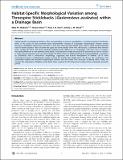Files in this item
Habitat-specific morphological variation among threespine sticklebacks (Gasterosteus aculeatus) within a drainage basin
Item metadata
| dc.contributor.author | Webster, Mike M. | |
| dc.contributor.author | Atton, Nicola | |
| dc.contributor.author | Hart, Paul J. B. | |
| dc.contributor.author | Ward, Ashley J. W. | |
| dc.date.accessioned | 2011-08-10T06:36:46Z | |
| dc.date.available | 2011-08-10T06:36:46Z | |
| dc.date.issued | 2011-06-15 | |
| dc.identifier.citation | Webster , M M , Atton , N , Hart , P J B & Ward , A J W 2011 , ' Habitat-specific morphological variation among threespine sticklebacks (Gasterosteus aculeatus) within a drainage basin ' , PLoS One , vol. 6 , no. 6 , e21060 . https://doi.org/10.1371/journal.pone.0021060 | en |
| dc.identifier.issn | 1932-6203 | |
| dc.identifier.other | PURE: 11733330 | |
| dc.identifier.other | PURE UUID: 4a05e870-2eef-4b8c-9db0-3d42c1db5666 | |
| dc.identifier.other | WOS: 000291730000046 | |
| dc.identifier.other | Scopus: 79958849530 | |
| dc.identifier.other | ORCID: /0000-0001-9597-6871/work/60427808 | |
| dc.identifier.uri | https://hdl.handle.net/10023/1958 | |
| dc.description | MMW was funded by a Natural Environment Research Council studentship (NERC, UK) awarded to PJBH. AJWW was supported by a DVC Grant from the University of Sydney. | en |
| dc.description.abstract | Habitat-specific morphological variation, often corresponding to resource specialization, is well documented in freshwater fishes. In this study we used landmark based morphometric analyses to investigate morphological variation among threespine sticklebacks (Gasterosteus aculeatus L.) from four interconnected habitat types within a single lowland drainage basin in eastern England. These included the upper and lower reaches of the river, the estuary, a connected ditch network and a coastal salt marsh. We found significant habitat-specific differences in morphology, with three axes of variation describing differences in orbit diameter, body depth, caudal peduncle shape and pectoral fin positioning as well as variation in relative dorsal and pelvic spine size. Interestingly, the ditch system, an artificial and heavily managed habitat, is populated by sticklebacks with a characteristic morphology, suggesting that human management of habitats can in some circumstances lead to morphological variation among the animals that inhabit them. We discuss the mechanisms that conceivably underlie the observed morphological variation and the further work necessary to identify them. Finally, we consider the implications of habitat-specific body shape variation for the behavioural ecology of this ecologically generalist species. | |
| dc.format.extent | 10 | |
| dc.language.iso | eng | |
| dc.relation.ispartof | PLoS One | en |
| dc.rights | © 2011 Webster et al. This is an open-access article distributed under the terms of the Creative Commons Attribution License, which permits unrestricted use, distribution, and reproduction in any medium, provided the original author and source are credited. | en |
| dc.subject | Influence association preferencesS | en |
| dc.subject | Sunfish lepomis-gibbosus | en |
| dc.subject | Sexual-dimorphism | en |
| dc.subject | Body Shape | en |
| dc.subject | Ecological specialization | en |
| dc.subject | Phenotypic plasticity | en |
| dc.subject | Social recognition | en |
| dc.subject | 3-spined stickleback | en |
| dc.subject | Inducible defenses | en |
| dc.subject | Adaptive radiation | en |
| dc.subject | QL Zoology | en |
| dc.subject.lcc | QL | en |
| dc.title | Habitat-specific morphological variation among threespine sticklebacks (Gasterosteus aculeatus) within a drainage basin | en |
| dc.type | Journal article | en |
| dc.description.version | Publisher PDF | en |
| dc.contributor.institution | University of St Andrews. School of Biology | en |
| dc.contributor.institution | University of St Andrews. Centre for Social Learning & Cognitive Evolution | en |
| dc.contributor.institution | University of St Andrews. Centre for Biological Diversity | en |
| dc.identifier.doi | https://doi.org/10.1371/journal.pone.0021060 | |
| dc.description.status | Peer reviewed | en |
This item appears in the following Collection(s)
Items in the St Andrews Research Repository are protected by copyright, with all rights reserved, unless otherwise indicated.

